http://www.ancient-origins.net/news-history-archaeology/primates-ancient-egypt-deification-and-importance-baboons-and-monkeys-part-021888
Primates of Ancient Egypt: The Deification and Importance of Baboons and Monkeys—Part I
The ancient Egyptians populated their vast pantheon of gods and goddesses with an incredible menagerie of animals and birds. These deities served as protectors, law-givers, healers, patrons of the arts and much more. From the run-of-the-mill creatures to the exotic—virtually every conceivable beast was venerated by the masses. Monkeys and baboons were also greatly regarded in various roles and contexts throughout Egyptian history. As the representatives of the gods and in their role as pets and helpers, these animals were dear to the people. Quite bizarrely, in addition to being trained to pick fruit and lend a hand in mundane chores; monkeys also formed an elite squad that was every criminal's worst nightmare! Evidence shows that the primates policed the streets with their human counterparts – much like canine companions of cops today.
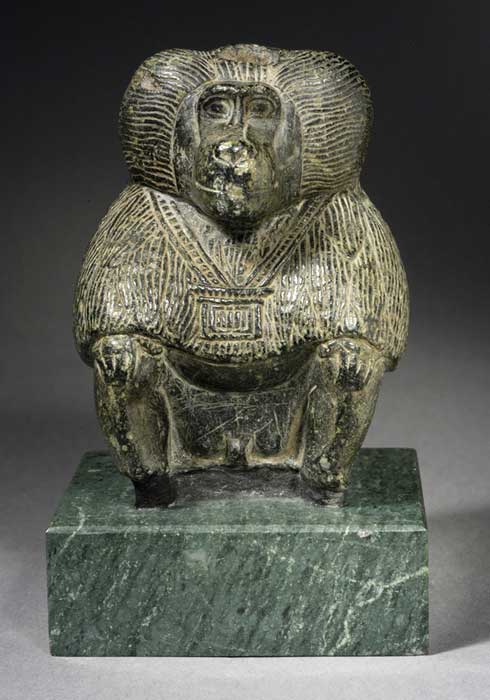
A Steatite sculpture of a seated Baboon representing the god of wisdom, Thoth. New Kingdom. Los Angeles County Museum of Art. ( public domain )
Hailing Baboons and Monkeys
The Egyptians were of the view that living beings, both big and small; feathered and scaled, were the repositories of magical powers. Endowed with special capabilities, these creatures were believed to communicate with the gods and perform the role of intermediaries between the multitude of deities and humankind. However, even though animals were considered sacred messengers, the populace did not worship them per se. On the contrary, they paid obeisance to the invisible and supernatural attributes of the deities that they believed manifested in animal form. And so, a range of beats and birds were heralded in cult centers dedicated to their worship across the land.
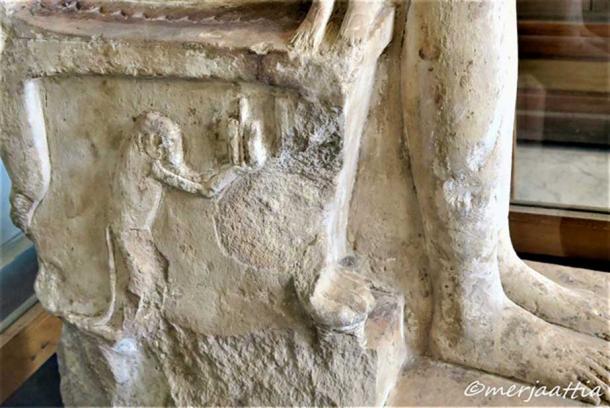
The sides of this seat from a group statue are decorated with images of baboons. On the right side, seen here, the animal is shown holding a cosmetic pot or kohl eyeliner. Painted limestone. 18th Dynasty. Egyptian Museum, Cairo.
The advent of baboons in religion can be traced back to the dawn of the Egyptian civilization; and one of the earliest pre-dynastic deities was the baboon god Baba (or Babi) – "Bull of the Baboons" who, it was thought, devoured the innards of the immoral dead. Examples of artistic representations of monkeys and baboons – be they sculptures, reliefs, or paintings – abounded throughout the country. Extant art from the Old and New Kingdom periods portrays the primates in different settings; and monkeys in particular are often shown engaging in human activities including, among other things - harvesting figs, playing musical instruments, dancing and even policing!
That's not all; monkeys can be seen in winepresses, lending a hand in beer production and rigging and building boats as well. "However, scholars such as Deiter Kessler believe that there were no trained monkeys in ancient Egypt, and that most such scenes have some sort of "religio-theological function", though particularly on New Kingdom ostraca there may have also been an element of humor," notes Egyptological scholar, Jimmy Dunn.
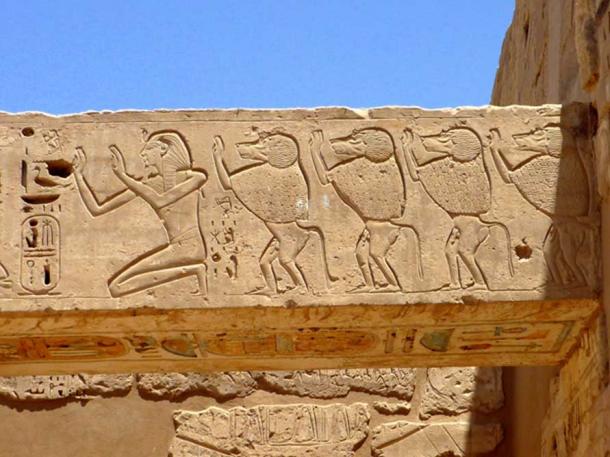
This relief from the mortuary temple of Ramesses III shows the king worshipping alongside sacred baboons. Medinet Habu, Theban Necropolis. (Photo: CC by SA 3.0 / Rémih )
The Egyptians regarded monkeys over and above their humorous antics; they considered them as erotic symbols linked to the cycle of birth, death, and rebirth. "Monkeys were evidently closely linked to female sexuality, probably on a less subtle level than the duck or goose. The baboon which, in some instances alternates with the monkey, had the phonetic value "nfr", a word which cannot always be translated by one equivalent English word. 'Good', 'Beautiful' and the like is the conventional rendering, but the word also implies something dynamic, creative and potent," writes Dr Lise Manniche.
In spite of their fearsome appearance and unpredictable nature, baboons and monkeys were nurtured as pets, with the latter being imported from Nubia. The Theban Queen Makare, was buried with her favorite female Green Monkey. This species was deified as an aspect of the invisible primeval god, Atum, particularly when depicted shooting with a bow and arrow. Evidence also suggests that these primates were exclusively reared in temples, like many other animals and birds that were associated with, and sacred to, specific deities.
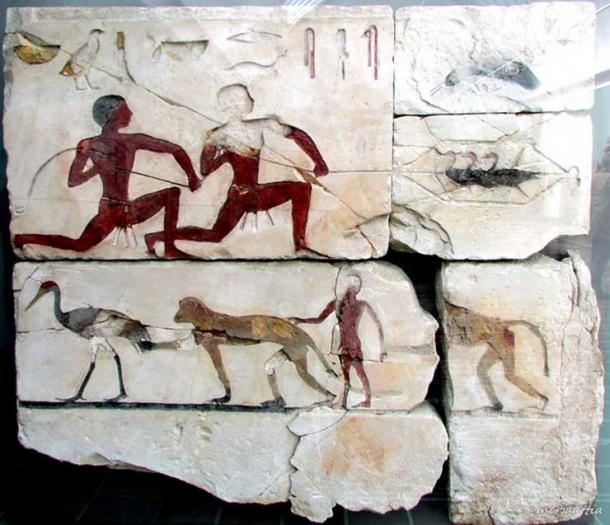
Two men are depicted catching birds, while in the lower register a boy is shown playing with two monkeys. Tomb of Atet, Meidum. Limestone with inlays. 4th Dynasty. Glyptotek, Copenhagen.
King's Connect with the Hamadryas
Experts opine that unlike baboons, monkeys were not worshipped in Egypt whilst they were alive. The animal was deified post mortem following its mummification, before which they spent their lives in temple sanctuaries. The ritual interment of monkeys in large necropolises dedicated to them and also in the burials of nobles and kings was a common practice.
Baboons depicted in art were predominantly the hamadryas (Papio hamadryas), a species from the Old World monkey family. Hamadryas baboons were associated with Thoth-Khonsu, the ibis-headed moon god who was worshipped as the god of wisdom and credited with devising hieroglyphics. Thoth also functioned as scribe to the gods and played a major part in Afterlife rituals. "At the Temple of Khonsu in Thebes, statues of Khonsu in the form of a baboon fronted the complex. In the Late Period, we know from a baboon tomb at Saqqara that the god Thoth-Khonsu became an important nocturnal oracle god, to whom written petitions were submitted. In this form, during the Greek Period, he was called Metasythmis, meaning ""hearing ear"," reveals Jimmy Dunn.
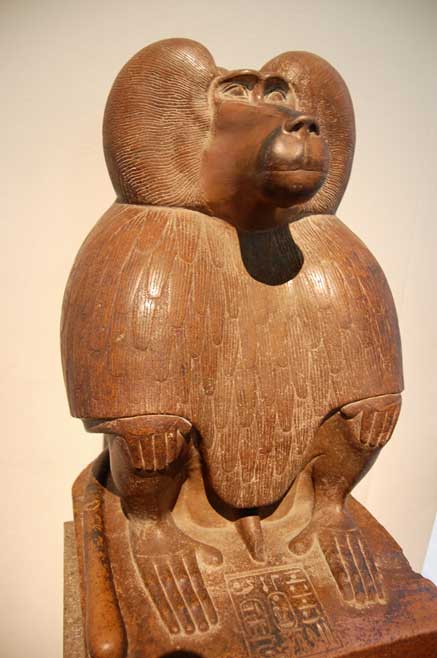
Quartzite sculpture of a seated hamadryas baboon (c. 1400 BC), depicting the god Thoth. British Museum. (Photo: CC by SA 3.0 / Steven G. Johnson )
Astennu, the attendant of Thoth, was represented as a hamadryas in his capacity as recorder of the outcome of the crucial Weighing of the Heart ceremony; and as one of the four hamadryas baboons guarding the Lake of Fire in Duat or the underworld. "The image of the Thoth baboon beside a wedjat eye occurs on magic wands as early as the twentieth century BC. Two baboon forms of the god Khons controlled The Books of the End of the Year. These contained lists of those who were destined to die and those who would live," explains Egyptologist, Dr Geraldine Pinch.
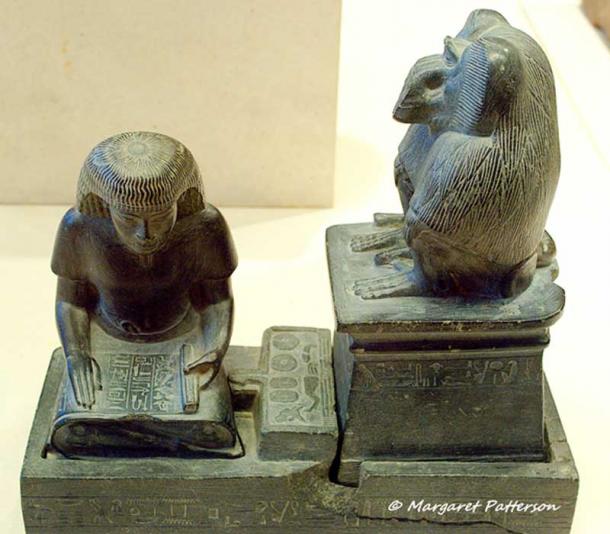
Scribe Nebmerutef is portrayed under the attentive gaze of the god Thoth, patron of writing. He is engrossed in reading a document, seated cross-legged on the ground, with his torso leaning slightly forward, and his right hand resting on the papyrus. Above him, the baboon sacred to Thoth is seated on a pedestal. New Kingdom. Louvre Museum, Paris.
During the ceremony to renew the physical world and the person of the ruler, individual ancestors were ritually deified in the form of baboons and received cultic offerings. The erection of wooden kiosks containing ancestor baboons at the Heb Sed-festival of royal rejuvenation may have developed from this earlier practice. An image of a baboon representing King Narmer, erected by an official, implicitly suggests the transformation of the king into a baboon, as part of a rejuvenation festival. It is interesting to note that the king was identified with a baboon god known as the "Great White One". Some scholars opine that the title of this god is derived from the silver-gray mane of a dominant hamadryas.
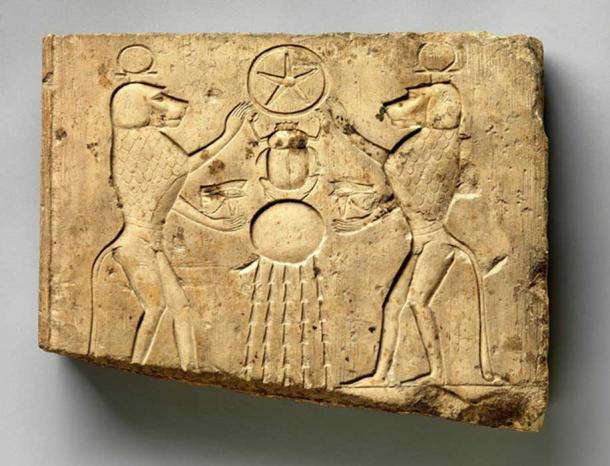
Limestone relief panel showing two baboons offering the wedjat eye to the sun god Khepri, who holds the Underworld sign. Late Period–Ptolemaic Period. Metropolitan Museum of Art , New York.
Essence of Divine Association
The most important aspect of baboons, however, was their association with Ra, the mighty sun god. In keeping with this, we find numerous depictions of these animals adoring the sun with raised arms, or holding a solar symbol. The baboon, in his aspect as Hapy, one of the four sons of the falcon-headed god Horus, was represented on canopic jar stoppers as he was in charge of protecting the lungs of the deceased. Hapy was also depicted in funerary literature as protecting the throne of Osiris in the Underworld.
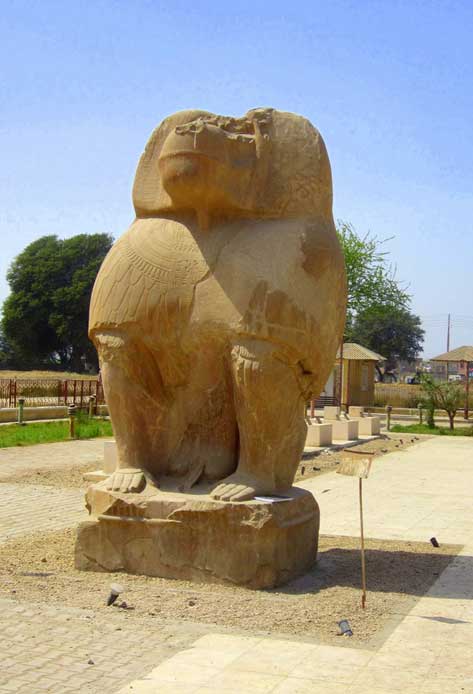
This large quartzite statue of Thoth as a baboon was erected by Pharaoh Amenhotep III. Hermopolis/El Ashmunein. (Photo: Tatiana Matveeva / flickr )
From the New Kingdom onward, temple statues of baboons are more in abundance. They frequently appear to be squatting on a raised platform, often accessed by a flight of stairs. Giant quartzite baboon sculptures from the reign of Amenhotep III have been found in Hermopolis, Middle Egypt. The age of votive mummies began during the Twenty-sixth Dynasty (Ca. 664 BC) and by the Late and Graeco-Roman Periods (332 BC -395 AD) we find buried in the necropolises various primates including hamadryas, baboons (Papio cynocephalus anubis), green monkeys (Cercopithecus aethiops), red monkeys (Cercopithecus pata), and the barbary ape (Macaca sylvanus).
[The author thanks Merja Attia and Margaret Patterson for granting permission to use their photographs in this series. The public archives of the Metropolitan Museum of Art can be accessed here.]
[Part 2 Coming Soon]
Top Image: Detail from one of the canopic jars of Padiouf, a priest of Amun, shows the face of the god Hapy ; design by Anand Balaji (Photo credit: Merja Attia); Deriv.
By Anand Balaji
Independent researcher and playwright Anand Balaji, is an Ancient Origins guest writer and author of Sands of Amarna: End of Akhenaten .
--
References:
Geraldine Pinch, Magic in Ancient Egypt , 2010
Jimmy Dunn, The Baboons and Monkeys of Ancient Egypt
Richard H. Wilkinson, The Complete Gods and Goddesses of Ancient Egypt , 2003
Geraldine Pinch, Handbook of Egyptian Mythology , 2002
John M. Adams, The Millionaire and the Mummies: Theodore Davis's Gilded Age in Egypt , 2013
Nicholas Reeves and Richard H. Wilkinson, The Complete Valley of the Kings , 2008
Thierry Benderitter, assorted articles, Osiris.net
Joyce Tyldesley, Judgement of the Pharaoh: Crime and Punishment in Ancient Egypt , 2000
Margaret Bunson, The Encyclopedia of Ancient Egypt , 1991
-- Sent from my Linux system.
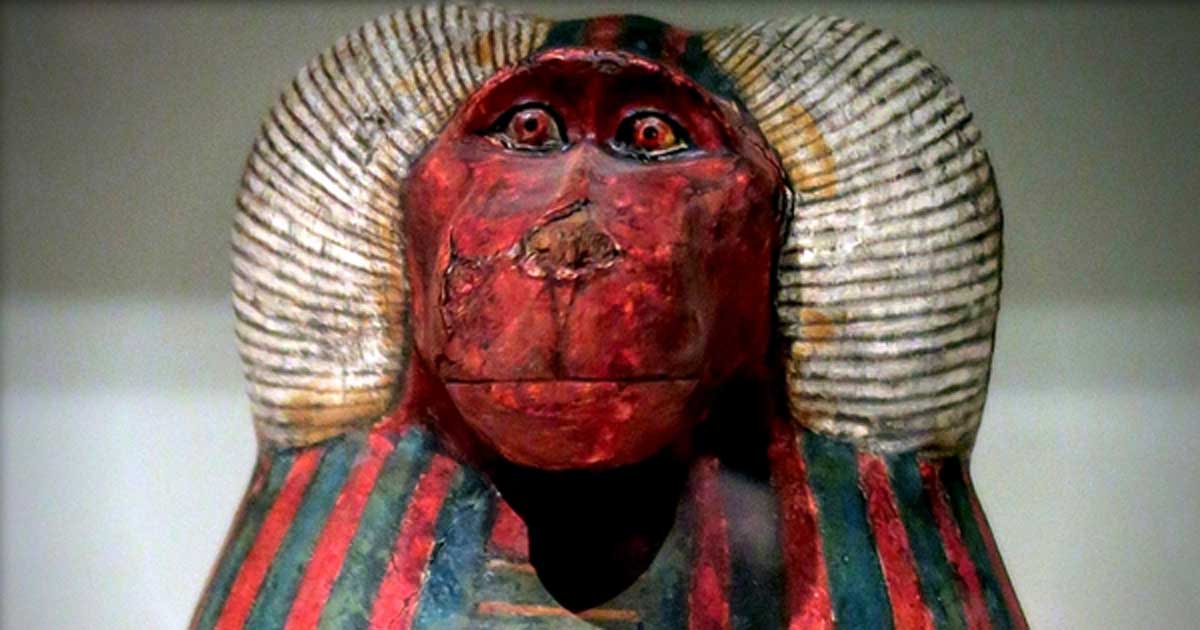
No comments:
Post a Comment